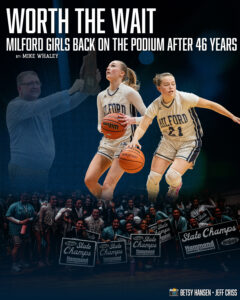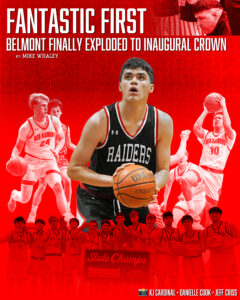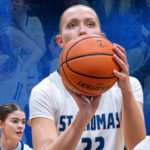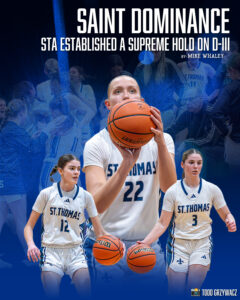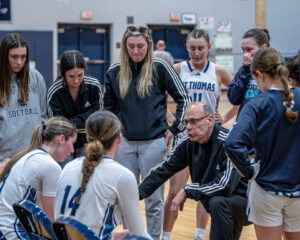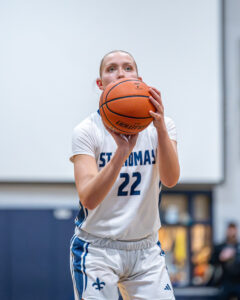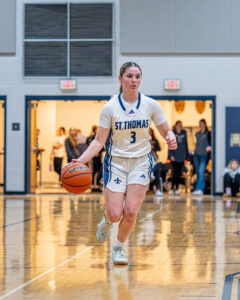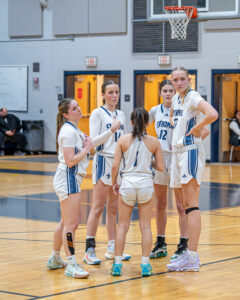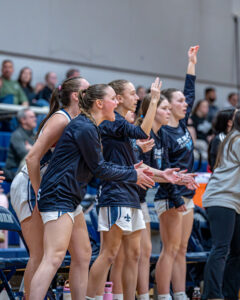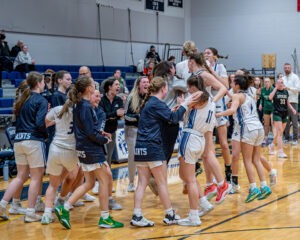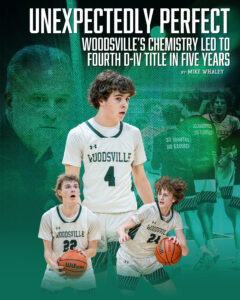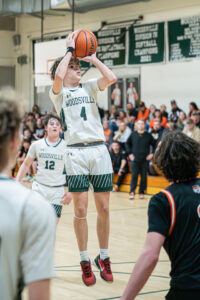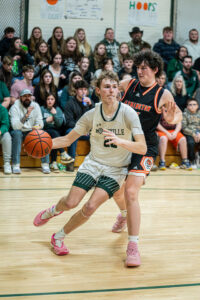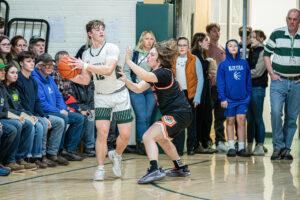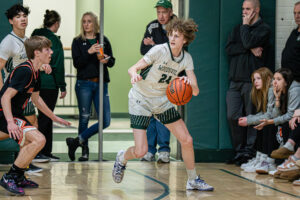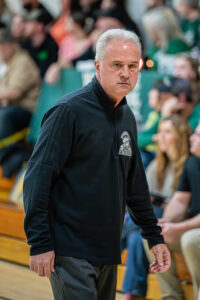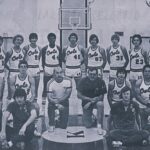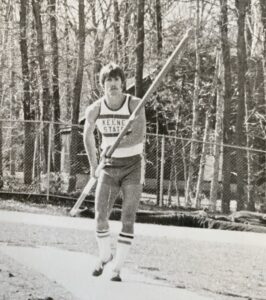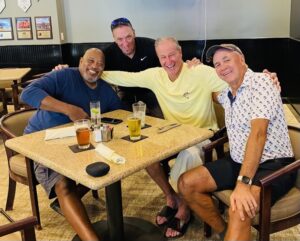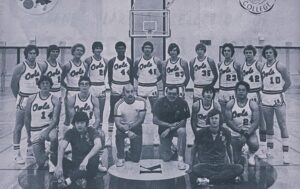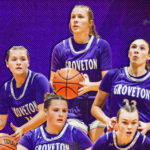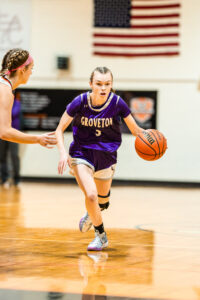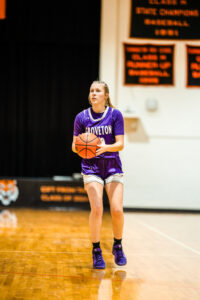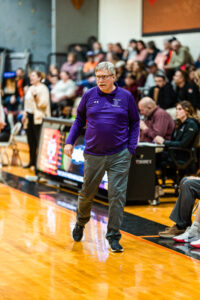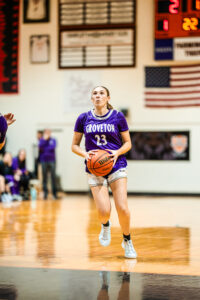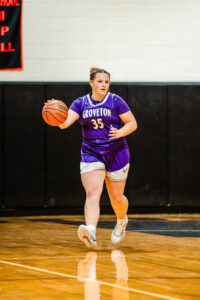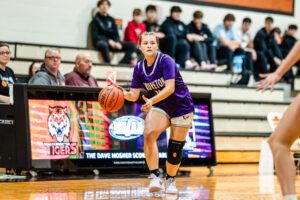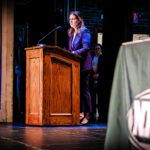By John Doyle
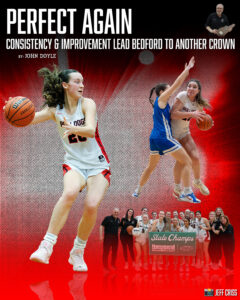 The Bedford High School girls basketball team had a perfect 2025 season — its second in a row as undefeated Division I champions.
The Bedford High School girls basketball team had a perfect 2025 season — its second in a row as undefeated Division I champions.
But Kevin Gibbs doesn’t measure perfection only in wins and losses. For the Bulldogs’ six-year veteran coach, it goes deeper than that.
“We have in-game goals,” Gibbs said. “And those goals are not related to winning and losing.”
Every night Bedford took the court, there was a checklist of goals — which could include keeping turnovers under 12, make 12 or more assists, holding opponents to single-digit scoring per quarter, or out-rebounding opponents by five or more.
Coach Gibbs noted that only twice this season did the team achieve all of its in-game goals, so in that way, perfection was not the main focus.
“It’s all the little components that, when added up, if you get the majority of them, you’ll win the game,” he said.
And win they did. After going 25-0 in 2024, the Bulldogs did it again this year en route to a second straight D-I crown.
Bedford’s run to the title — which was made official with a 50-44 win over rival Londonderry — was its third in five seasons and fifth straight trip to the D-I final.
While the Bulldogs’ natural inclination was to win every night, the prospect of a second-straight unbeaten season was never explicitly discussed.
“We never said we’re going to go undefeated this season or we’re going to come out with a championship,” said forward Mel McCarthy, a rising junior. “Obviously, everyone thought that in the back of their mind, but we focused more on little end-game goals to win that specific game, focus on the next play, get back on defense. Then the wins will come with that. We never really looked at the ‘big’ big picture.”
As is to be expected in the world of high school sports, Bedford’s 2025 season featured blowouts — 67-14 over Manchester Memorial, 70-21 over Merrimack and 68-20 over Keene to name a few. But there were plenty of close games too. The Bulldogs twice defeated Pinkerton in championship-game rematches, 65-52 at home and 48-43 in Derry. In that second game, the teams were tied entering the fourth quarter and neither led by more than 3 until Bedford forward Kate Allard put the win on ice with a pair of late free throws.
A February showdown against then-undefeated Londonderry in the final game of the regular season saw the Bulldogs trail by 9 in the fourth quarter — their biggest deficit of the season — before finishing the contest on a 16-0 run.
Even then, with the playoffs up next and another championship just four wins away, the word “undefeated” was still implicitly taboo in the Bulldogs’ locker room.
“This is going to blow your mind, but it was never discussed,” Gibbs said. “They truly embraced playing the game that was right ahead of them.”
The seeds of Bedford’s success were planted around the time the school opened in 2007 — when members of the current squad were babies or, in some cases, not even born. That’s because the school has always integrated the entire Bedford community into its development process, by doing such things as inviting youth programs to games, hosting camps for young basketball players in town and holding joint practices with the middle school teams.
“We would always go to the high school games, so we all thought they were celebrities,” said Allard, who will take her game to the next level at Boston University this fall. “So it’s really fun having that — seeing both sides, being that little kid and talking with the little kids now.”
Such early exposure to Bedford basketball not only immerses young players to the Bulldogs’ style of play, but also instills a sense of town pride and a strong desire to someday represent Bedford on the big stage as a member of the varsity basketball squad.
“We’re not making robots,” Gibbs said. “We’re trying to build kids who can succeed both on and off the court. And that, I think, is one of the reasons why we’ve achieved success — we have kids who buy into the fact that they’re being given responsibility and they don’t abuse it, they embrace it.”
Of course, playing any sport at Bedford means having a target on your back. The Bulldogs also won titles this year in boys basketball, boys tennis, and volleyball this season, and had a number of deep playoff runs in other sports.
Rising senior Annie Zink said that when you play for Bedford, being “the hunted” just comes with the territory. But she and her teammates took the challenge in stride.
“Any sport you play at Bedford, that’s usually what happens,” said Zink, a point guard. “They want to beat Bedford, so you always have it in the back of your mind. But I think we faced it as a challenge, and just something that made us work even harder in practice because we wanted to keep that undefeated streak so much. I think it was good motivation. It was hard to do, but it pushed us to want more.”
A high school basketball team will naturally turn over its entire roster in five years, so sustained success over that span points to one constant — strong, dedicated coaching. Still, Gibbs considers himself blessed to have at his disposal a seemingly never-ending flow of talented and dedicated players.
“Coaches sometimes take way too much of the credit when, in fact, it’s the kids that are doing the work,” Gibbs said. “If you have good team leadership, if you have athletes that really get it and create a model that kids see as being successful, then the kids want to emulate that model, and it just kind of builds on itself.”
Can Bedford make it three titles in a row, and maybe a third undefeated season to boot? The players might not talk about it among themselves, but the thought is already there.
“We’ll continue to reach for that standard because that’s what we want and that’s what we can achieve,” said Sarah Muir, a rising senior guard. “So our goal is to be at UNH again with the same record. Some people may crumble, but I feel like it kind of gives us that motivation to kind of do it again.”






